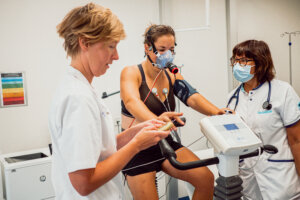Podiatric testing with step and gait analysis
For whom?
For whom?- Athletes
Each sport is different and is performed with certain footwear. Each sport demands something particular from your body. A tailored examination with individualised treatment is also very important for this reason. Having the right shoes is important. No matter whether you are a novice athlete or whether you are performing at an advanced level; for those who do recreational sports or who engage in competitive sports. Stress injuries suffered while jogging or cycling, playing football, tennis, doing gymnastics or while working towards your athletic ambitions are common.
Seek treatment for your symptoms or undergo a preventative screening. A preventative screening looks at all risk factors in order to minimise the chance of injury.
- Children
Children's feet are still growing and developing. We are able to influence the way in which you take steps and place your foot in order to prevent future problems.
Are you worried about something else you have noticed about your child (flat feet, regular tripping, heel pain after training, etcetera)? Do not hesitate to contact us for a preventative screening.
Procedure
Procedure1. Questionnaire (history)
Using an extensive questionnaire and focused intake interview, we try as much as possible to understand your prior history and your symptoms. We also look at your shoes and your athletic shoes.
2. Clinical and biomechanical testing
We examine the feet, knees, hips, pelvis and low back using fundamental and detailed testing. We use all sorts of testing and measurements to examine you from head to toe, in the most detailed way possible. This allows us to look at how your joints move, as well as how strong and long your muscles are.
3. Step and gait analysis with plantar pressure measurement
Step and gait analysis allows us to look at your movement pattern wiith a high-speed camera and specialised software. The video images are then analysed. We look at the foot's pressure distribution with a pressure plate. We look at how your body moves and then, if applicable, find the relation that this has with your symptoms.
Treatment
TreatmentAfter the test, we look at the collected information together and come up with a treatment plan. You may need to change the shoes you wear. You may need functional soles. Or you may need to be referred to a physician, specialist or a paramedic. Please see below for an overview of the most common treatments.
Functional insole therapy
If the testing indicates that you need therapeutic insoles, we first take an impression of your feet using an ultra precise 3D scan. On the basis of this scan, your insoles will be digitally custom-made. In addition, we keep each patient's specific requirements in mind, from hardness, shape and any other relevant aspects. When you come in to pick up your insoles, we will fit them to your feet and shoes. After four to six weeks, you will come in for a follow-up test. At this time, we will be able to closely examine what effect the soles have had on your symptoms.
(Sport) shoe recommendations
The right shoes can prevent a lot of suffering and pain. A good pair of shoes, in combination with insoles, is also important. And the right pair of shoes is different for everyone, especially for running and sports shoes. If the testing shows that we can solve the problem with the right shoes, then we will review all the options together in order to give you individualised shoe recommendations.
Multidisciplinary approach
In our Sports Medicine Centre, we work closely with the sports medicine physicians and physical therapists, as well as with other hospital departments. If the testing shows that another cause could be responsible for your symptoms, then we refer you so that your symptoms can be considered from all angles.
Practical information
Practical information- The testing will take approximately one-and-a-half hours. This leaves enough time to gather all the information, take all the measurements, discuss the results together and form an individualised treatment plan.
- What do I need to bring?
- Athletic shirt and shorts (above the knee)
- A pair of shoes that you wear daily and a pair of athletic shoes
- Current insoles, if applicable
- Any medical imaging or other relevant medical reports
Centres and specialist areas
Centres and specialist areasLatest publication date: 12/04/2024



